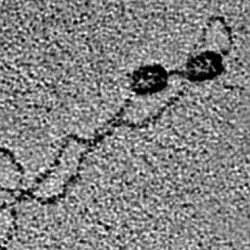By Helen Figueira
March 11, 2013
Time to read: 3 minutes
 MCM molecules recruited sequentially during DNA replication
MCM molecules recruited sequentially during DNA replication
Imagine trying to make a full-size, brick-by-brick replica of a house. To get the job done you’d need a clear, ordered plan – you don’t want a cement mixer in the way of your crane, or a roof put on before the walls are finished. The situation is the same as DNA tries to replicate itself. Molecular machinery and mechanisms are precisely choreographed to ensure that no single brick is put in the wrong place. New work from the CSC, published in Nucleic Acids Research, reveals the details of this complicated operation.
Each time a cell divides, it makes a full copy of our DNA. Any errors in this process can lead to mutations. One of the most important elements in the early stages of replication is the helicase – a protein complex that picks apart the two strands of DNA. Christian Speck (DNA Replication Group) wants to know how it forms and loads onto the DNA. Previous work from Speck’s lab showed that when loaded onto DNA, the helicase is a double hexamer, composed of two ring structures joined together.
In order to load these rings onto the DNA, they must open, move over the DNA, and close. Speck’s recent study considers four main players in the loading process: ORC (the Origin Recognition Complex) works with Cdc6, Cdt1 to load MCM2-7 hexamers onto DNA. “Our question was how the complex initially forms,” says Speck. “We had to unpick the different steps in the reaction process.” To break down the process Speck and his team blocked ATP hydrolysis. This removes the fuel powering the reaction, and limits its progress.
“We found there was then only one MCM hexamer in complex with ORC-Cdc6 and Cdt1,” says Speck. “That was a surprise, and allowed us to discount previously proposed models that implied that there would be multiple MCMs. This means that the formation of the helicase is sequential. One ring is recruited, and then the other. This is an essential step in the cell’s preparation for DNA replication.”
Digging deeper, the study unearthed more about what role specific motifs in the proteins play in helicase loading. Experiments with four Cdc6 mutants revealed which subunits play a role in ATP hydrolysis (‘Walker B’ and ‘Sensor 1’), and which are important for positioning (‘Walker A’ and ‘Sensor 2’). With these motifs lying far apart in the protein’s primary amino acid sequence, it was a surprise that they should fall into these classes of behaviour; it wasn’t until the 3D conformation of the proteins was considered that it became clear that the close proximity of these elements in the final structure was key to their shared functions.
Despite the detailed molecular nature of the work, its practical importance is significant, with tantalising potential applications in therapy for cancer and Meier-Gorlin Syndrome. As Speck remarks, “this is a fundamental biological question, and we’re looking at the first of many steps in the reaction. But the more we understand it, the better the hope for long-term therapy development.”
AL
Reference: Evrin, C., Fernández-Cid, A., Zech, J., Herrera, M. C., Riera, A., Clarke, P., Brill, S., Lurz, R., Speck, C., (2013). In the absence of ATPase activity, pre-RC formation is blocked prior to MCM2–7 hexamer dimerization. Nucleic Acids Research. Abstract
Image: Electron micrograph image of two MCM2-7 helicase complexes bound to DNA.